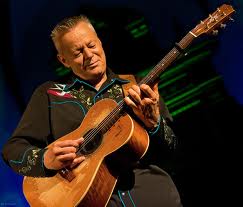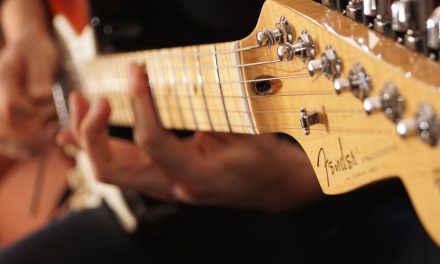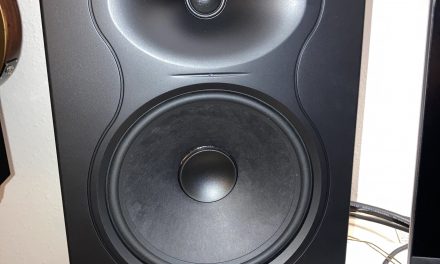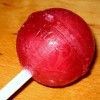Tommy Emmanuel Concert Review
Last night, my brother-in-law John and I went to see Tommy Emmanuel perform at the Capital Theater in Clearwater. It has 750 seats, great acoustics, a great sound system, and the seat rows are far too close together. If you’re more than 6 foot tall, you might not fit in the seats without your knees pushing into the seat in front of you.
We’re both guitar players and we both own several guitars. I’ve been wanting to see Tommy for a couple of years now, so it was a thrill to finally get a chance. Tommy did two sold out shows on a Friday and Saturday night. We were there Saturday. There were some empty seats, likely no-shows.
Tommy had an opening act. A guy named Antsy McClain who was really, really good. I’d call him a Comedy Singer Songwriter. He had great songs and was honestly really funny. At the end of Tommy’s set, he called Antsy out and gave him the spotlight for the last two songs. Tommy is total class. Their friendship is a real thing and you can see it on stage. Or in this brief clip from their tour bus:
Anyway, Tommy came on and started playing and was amazing. You’d expect him to do the flashy stuff, you know, blazing speed, playing with one hand, playing two songs at the same time, playing drums, bass, chords, and melody all at the same time on his beat up acoustic, and he did all that stuff. But as amazing as that was, I was more blown away by the slower, softer compositions. John and I both agreed the best song of the night is the one he wrote for his daughter. I think it was called “It’s never too late.” It was spectacular. The theater melted away and the hair on my arms stood up. Tommy is the best guitar player I’ve ever seen, and I’ve seen some good ones, but more than that, Tommy is a true musical genius.
You’re saying “Yeah, yeah. Details, man! Details!” OK.
Tommy had three Maton guitars with him that he rotated through. Maton is a guitar company out of Australia. One was beat to shit, and he used that any time he was pounding on it like a set of bongos. One was downtuned a whole step. He gave us some details on the strings, but all I remember is the high E was a 13. And then the third guitar was regular tuning. All three use a plug in the sound hole, all three sounded great, and the house PA sounded amazing.
I thought Tommy was using three pedals – a tuner, a reverb, and a delay. But in actuality he only uses a tuner and a DI box (an AER Colourizer, if you’re interested.) He also has a guitar amp on stage, but he keeps the volume on it fairly low – just loud enough for him to hear. His sound engineer sometimes adds reverb and delay. I found this out after Googling him. Tommy is a sound engineer’s dream – one guitar and one microphone. Compare that to miking up Rush, especially the drums. But he actually travels with his own sound engineer. Sweet gig.
I also found out he uses 12 to 54 Martin FX strings. Pretty light gauge for an acoustic, but nice to know that the idea of needing heavier gauge strings on an acoustic is bullshit.
Tommy plays Chet Atkins style, with his thumb usually playing a bass line and the index, pointer, and ring finger doing the rest. He uses his pinkie as a base, which I found interesting. As a result, on at least one of his guitars you can see the finish worn away where his pinkie anchors. On some songs, he used a thumb pick, and on some others, a regular flat pick, and for some songs he used just his fingers.
The secret to Tommy’s playing is his skills as an arranger. He’s a word class player, but he’s able to do arrangements with a bass line, chords, and a melody in a way that creates a really full sound. He’s also good at using his guitar’s three band EQ to emphasize different frequencies on different songs. For a song with a strong melody, he’ll back off the bass.
Another thing about his playing is his dynamics. This is one of the reasons Tommy plays acoustic instead of electric. You can play with dynamics on an electric, but an acoustic has a massive difference in sounds between soft and loud. This makes his arrangements far more interesting. Most guitarists today have no dynamics (me included.)
But the final detail is his joy of music, which you can see in his body language and his face. If you want a lesson on how to really put yourself into the song, watch Tommy. It’s not just for show. I learned this studying piano in the prep department at Eastman – body language can have a huge impact on your music.
Conclusion – I labeled this a review, but really I’m just gushing. If you play guitar and you have a chance to see Tommy, you have to go see him. You just have to. He’s amazing beyond belief. I’m not qualified to even look for flaws in his game. He played some chords that I’ve never heard before. Sometimes I was totally lost in terms of trying to understand what he was doing, musically.





